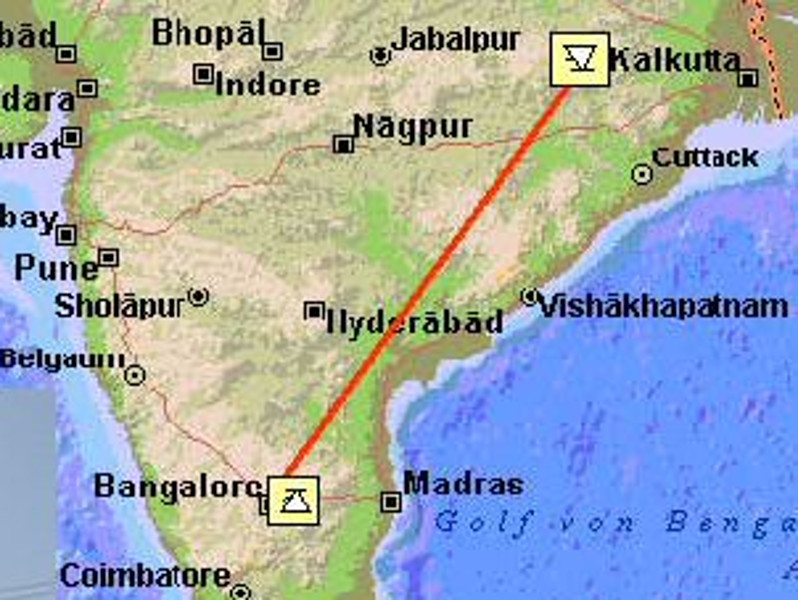The Talcher-Kolar high-voltage direct current (HVDC) link, also known as the East-South HVDC Interconnector II, is the longest power transmission line in India and one of the longest in the world.
The 1,450km-long transmission line originates from the Talcher power generation centre in Odisha in eastern India and terminates at Kolar near Bangalore in the Southern Indian state of Karnataka.
Owned and operated by Power Grid Corporation of India (PGCIL), the Talcher-Kolar HVDC link was commissioned in February 2003.
The initial transmission capacity of the inter-state power line was 2000MW, which was later upgraded to 2,500 MW in 2007.
Project Gallery
-

The Talcher-Kolar HVDC link is India’s longest power transmission line. Image courtesy of Siemens AG.
-

The Talcher-Kolar HVDC link was commissioned in February 2003. Image courtesy of Maschinenfabrik Reinhausen (MR).
-

The transmission capacity Talcher-Kolar HVDC link is 2,500 MW. Image courtesy of Maschinenfabrik Reinhausen (MR).
Talcher-Kolar HVDC link details
The Talcher-Kolar inter-regional transmission line was built with an estimated investment of £168m ($220m) for long-distance power supply from the Talcher super thermal power station located in the Angul district of Odisha.
Talcher super thermal power station, also known as NTPC Talcher Kaniha, is the first mega coal-fired power plant in India with an installed capacity of 3GW.
Owned and operated by India’s state-owned National Thermal Power Corporation (NTPC), the five-unit power plant is supplied with coal from the Lingraj and Kaniha coal blocks of the Mahanadi Coalfields, while water supply is received from the Samal Barrage Reservoir on the Brahmani River.
The plant supplies electricity to the states of Odisha, Andhra Pradesh, Karnataka, Telangana, Bihar, and West Bengal.
Construction of the Talcher-Kolar HVDC link was started in March 2000. The 1,450km-long transmission line passes through Odisha, Andhra Pradesh, and Telangana to deliver electricity to the industrial city of Kolar in Karnataka.
At the time of commissioning in 2003, the Talcher-Kolar HVDC link was the world’s second-longest power transmission line.
East-South HVDC Interconnector II design
The Talcher-Kolar long-distance HVDC link comprises two terminal substations located at Talcher and Kolar, respectively.
The voltage capacity of the bi-polar, overhead, direct current transmission line is 500kV.
Electricity is converted from alternating current (AC) to direct current (DC) at the Talcher substation, while DC to AC conversion occurs at the Kolar terminal substation.
Each substation comprises seven single-phase converter transformers rated at 397 MVA, 3,888 electrical triggered thyristors (ETT), a dry air-core type smoothing reactor, and nine double-tuned (DT) AC filters.
The insulation and barriers within the converter valves are made of flame-retardant materials to reduce the risk of fire.
Control and protection system
The Talcher-Kolar HVDC link features a fully redundant and digitised control and protection system. Apart from the optimum control of the electricity transmission, the protection system is designed to selectively disconnect and isolate faulty equipment to prevent unnecessary system shutdowns and prevent damage to the components of the HVDC transmission system.
The remote control interface from load dispatch centres and telecom interface to corresponding converter stations are integrated into the operator control level.
Siemens’ Pulse-Echo Monitoring System (PEMO) has been implemented to detect faults on the 35km long ground electrode lines at both the terminal stations.
Contractors involved
Siemens Power Transmission and Distribution, a subsidiary of Siemens was awarded the engineering, procurement, and construction (EPC) contract for both the substations of the Talcher-Kolar HVDC link in 2000.
Maschinenfabrik Reinhausen (MR), a power engineering company based in Germany, was engaged to service 12 tap changers and to inspect 24 transformer columns on six Siemens transformers of the Talcher-Kolar HVDC transmission system in March 2017.
